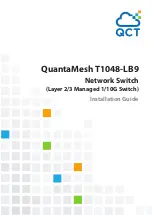
Port Management
PoE
Cisco Sx350, SG350X, SG350XG, Sx550X & SG550XG Series Managed Switches, Firmware Release 2.2.5.x
164
9
Operation
PoE implements in the following stages:
•
Detection
—Sends special pulses on the copper cable. When a PoE device is located at
the other end, that device responds to these pulses.
•
Classification
—Negotiation between the Power Sourcing Equipment (PSE) and the
Pod Device (PD) commences after the Detection stage. During negotiation, the PD
specifies its class, which indicates maximum amount of power that the PD consumes.
•
Power Consumption
—After the classification stage completes, the PSE provides
power to the PD. If the PD supports PoE, but without classification, it is assumed to be
class 0 (the maximum). If a PD tries to consume more power than permitted by the
standard, the PSE stops supplying power to the port.
PoE supports two modes:
•
Port Limit
—The maximum power the device agrees to supply is limited to the value
the system administrator configures, regardless of the Classification result.
•
Class Power Limit
—The maximum power the device agrees to supply is determined
by the results of the Classification stage. This means that it is set as per the Client's
request.
PoE Devices
Uplink ports may function as a Powered Device (PD), with 1 or 2 PD ports. On 8-port devices,
the highest port will be the PD (PD ports do not have Power Sourcing Equipment (PSE)
functionality). If there are 2 PD ports, it is recommended to connect them to a single PSE.
Both PD ports are functional, if they are powered with the same power standard (both AF, both
AT or both 60W PoE).
For 60W PoE PSE devices, the PSE port types are:
The Power over Ethernet (PoE) feature is only available on the following PoE-based devices.
24-port devices
48-port devices
350
4 60W PoE ports, 20 ports AT
8 ports 60W PoE, 40 ports AT
550
8 60W PoE ports, 16 ports AT
16 ports 60W PoE, 32 ports AT
SKU Name
PoE PD 60W PoE/AT/AF
PoE PSE AF/AT
SF350-08
AT
N/A
















































